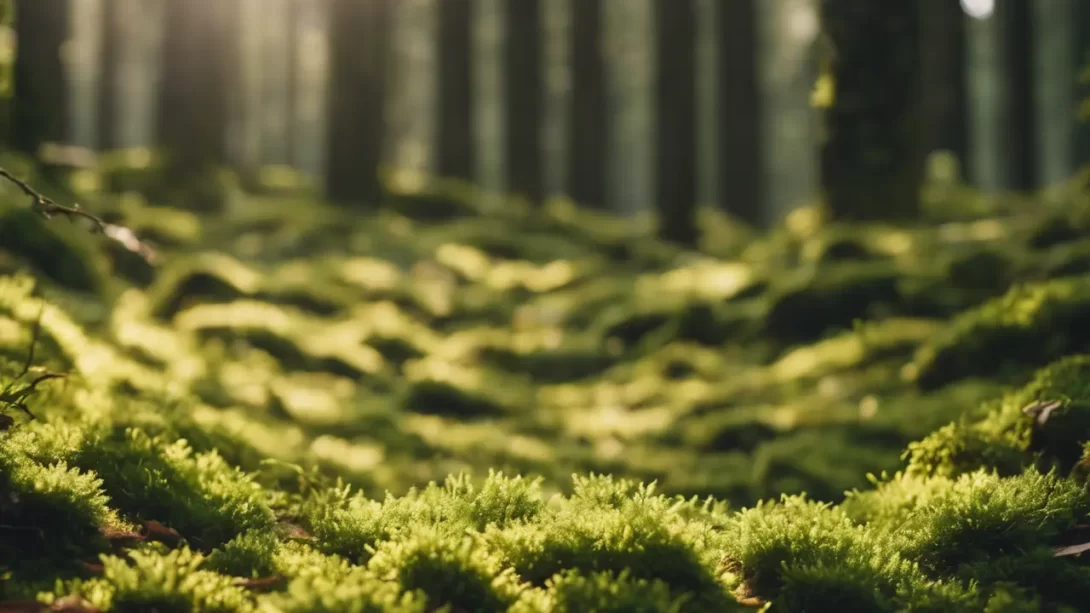Mosses are a fascinating group of non-vascular plants that adorn many natural landscapes with their soft, green carpet-like appearance. A common question regarding these plants is their need for sunlight. Unlike most plants, mosses have unique characteristics that influence their sunlight requirements, which this article aims to explore.
Moss
Mosses are small, soft plants that typically form dense green clumps or mats in damp or shady locations. They belong to the bryophyte group and are known for their lack of traditional roots, leaves, and stems. Instead, they have rhizoids for anchoring and simple leaves for photosynthesis. Mosses are found in various environments, from deep forests to rocky outcroppings, and even in urban settings. Their ability to thrive in diverse conditions raises questions about their specific needs for sunlight.
Photosynthesis in Moss
Like other green plants, mosses perform photosynthesis – the process of converting light energy into chemical energy. Sunlight is a key component of this process, providing the energy required for mosses to produce food. However, the efficiency of photosynthesis in mosses differs from that in vascular plants. Mosses have adapted to perform photosynthesis efficiently in low-light conditions, often found under the canopies of larger plants or in shaded, moist areas.
Sunlight Requirements for Moss
Mosses generally prefer indirect or diffused sunlight rather than direct exposure. While they need some level of light to conduct photosynthesis, most species of moss are adapted to low-light environments. This is why mosses are commonly found growing on the north side of trees or rocks in the northern hemisphere, where sunlight is less direct. Excessive sunlight can actually be detrimental to moss, leading to desiccation and reduced growth.
Variations Among Moss Species
The sunlight requirements for moss can vary significantly among different species. Some mosses have adapted to relatively high levels of sunlight and can be found in open, exposed areas. For example, species like Ceratodon purpureus are often seen in urban environments, growing on rooftops and sidewalks where they receive more direct sunlight. On the other hand, species such as Leucobryum glaucum prefer shaded, forested areas and are sensitive to prolonged direct sunlight. Understanding the specific needs of different moss species is crucial for their successful cultivation and maintenance.
Factors Influencing Moss Growth
Besides sunlight, several other environmental factors play a critical role in the growth and health of moss. Moisture is perhaps the most significant of these factors. Mosses require a damp environment for optimal growth, relying on a high level of ambient moisture in the air and soil. Temperature also affects moss, with most species preferring cooler conditions. The type of substrate, or surface on which the moss grows, can further influence its health and spread. Mosses can grow on a variety of substrates, including soil, rock, and wood, but the suitability of each can vary depending on the species.
Cultivating Moss in Gardens and Landscapes
For gardeners interested in cultivating moss, understanding its preference for indirect sunlight and other environmental needs is essential. Creating a moss garden or incorporating moss into a landscape requires selecting an appropriate location that mimics the moss’s natural habitat. This often means choosing shaded areas with moist, cool conditions. Ensuring that the chosen area stays damp can be achieved through regular misting or installing a water feature. Additionally, selecting the right type of moss for the specific light conditions of the garden is crucial for successful growth.
Conclusion
In summary, while mosses do require sunlight for photosynthesis, their need differs significantly from that of many other plants. Most moss species are adapted to low-light environments and can thrive in indirect or diffused sunlight. Understanding the specific sunlight requirements of different moss species is crucial for their cultivation and maintenance. Gardeners looking to grow moss should consider not only the light conditions but also ensure adequate moisture and suitable substrates to mimic the moss’s natural habitat.
The unique characteristics of mosses, including their ability to grow in low-light conditions, make them an excellent choice for adding greenery to shaded areas in gardens and landscapes. Their versatility and low maintenance requirements also make them a popular choice for creating serene, green spaces in urban environments.
Recognizing the adaptability and ecological role of moss contributes to a greater appreciation of these fascinating plants. By respecting their natural growing conditions and requirements, we can successfully integrate moss into our gardens, creating lush, verdant landscapes that thrive with minimal intervention. Mosses not only enhance the beauty of our surroundings but also remind us of the diversity and resilience of nature’s flora.



